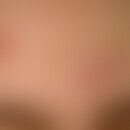Synonym(s)
HistoryThis section has been translated automatically.
DefinitionThis section has been translated automatically.
Rather rare acneiform drug reaction to bromine-containing drugs. Bromides and organic bromine compounds including bromourea derivatives such as Cabromal are now considered outdated sedative therapeutic principles; they were formerly used as sleeping pills, among other things. Danger of bromine intoxication (bromism), especially because of extremely long half-life (20 days) of bromide in the body! Recently, bromine-containing drugs have been used as cytostatics in myeloproliferative diseases (Pipobroman [Vercite]; approved in France for the treatment of polycythemia vera). Furthermore, bromine-containing antiepileptic drugs exist (potassium bromide Desitin); used e.g. in the context of anticonvulsive therapy in Dravet syndrome.
You might also be interested in
Occurrence/EpidemiologyThis section has been translated automatically.
LocalizationThis section has been translated automatically.
ClinicThis section has been translated automatically.
DiagnosisThis section has been translated automatically.
Notice!
In case of doubt the excretion of bromine in urine can be measured!Differential diagnosisThis section has been translated automatically.
- Acne vulgaris (acne typical distribution, wrong age, no comedones).
- Acne-form exanthema (largely identical clinic; however, the medical history of the bromide medication is missing; see etiology of acne-form exanthema).
- Acne-like syphilide (acne-like distributed clinical picture without comedones, no typical follicular relation, papules rather brown than red; serology!)
- Pyoderma faciale (acne conglobata-like, peracute to subacute clinical picture, especially in young women with pustules and deep abscesses on the face).
- Follicular pyoderma (numerous pustules, also follicular nodules, no comedones; smear with evidence of the pathogens; painful lymphadenitis)
- Tinea barbae (folliculitis and formation of furunculoid nodes. Diseased hair can be epilated painlessly. Native fungus detection possible; fungal culture positive).
External therapyThis section has been translated automatically.
Internal therapyThis section has been translated automatically.
Progression/forecastThis section has been translated automatically.
LiteratureThis section has been translated automatically.
- Sobottka A et al (2008) Conglobulating indurated nodules and pustules in the face of a 55-year-old patient. Dermatologist 59: 734-736
- Van der Meiren (1950) A case fo vegetative bromoderma. arch Belg Dermatol Syphiligr 6: 269-271
Incoming links (11)
Blastomycosis, north american; Blastomycosis south american; Bromine acne; Bromoderma tuberosum; Bromoderma vegetans; Fluoroderm; Halogenoderm; Iododerma tuberosum; Rosacea fulminans; Tuberculosis cutis verrucosa; ... Show allOutgoing links (11)
Acne (overview); Exanthema, acneiformes; Glucocorticosteroids systemic; Hyphilide, acneiformes; Komedo; Myeloproliferative diseases; Prednisone; Pyoderma; Tinea barbae; Triamcinolone acetonide; ... Show allDisclaimer
Please ask your physician for a reliable diagnosis. This website is only meant as a reference.




